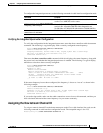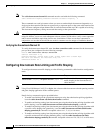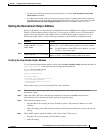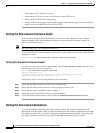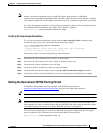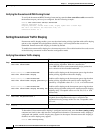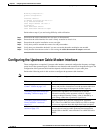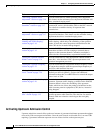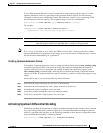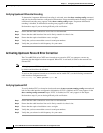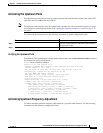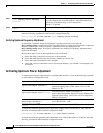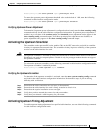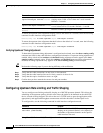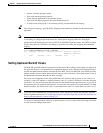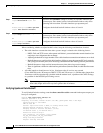
3-13
Cisco uBR7200 Series Universal Broadband Router Software Configuration Guide
OL-2239-03
Chapter3 Configuring Cable Modem Interface Features
Configuring the Upstream Cable Modem Interface
Cisco CMTS upstream admission control is turned off by default and must be activated. To set the
upstream admission control as a percentage of the upstream channel capacity, use the following
command in cable interface configuration mode. The admission control is set as a percentage of the
specified upstream channel capacity. The acceptable range is from 10 to 1000 percent.
Router(config-if)# cable upstream usport admission-control percentage
For example:
7246VXR(config-if)#cable upstream 0 admission-control ?
Max Reservation Limit As Percentage of Raw Channel Capacity
Syntax Description
Note If percentage is left blank or set to 100%, the CMTS will only allow a total up to the real available
upstream bandwidth to be guaranteed. If percentage is set to its maximum of 1000, then up to 10 times
the real interface bandwidth may be “guaranteed”.
Verifying Upstream Admission Control
To determine if upstream admission control is configured and activated, enter the showrunning-config
command in privileged EXEC mode and look for the cable interface configuration information. If
upstream admission control is configured and enabled, an admission control entry appears in the
showrunning-config command output, indicating the user-defined percentage of upstream channel
capacity allowable. If upstream admission control is disabled, no admission control entry appears in the
output.
Perform these steps if you are having difficulty with verification:
Step1 Ensure that the cable connections are not loose or disconnected.
Step2 Ensure that the cable interface line card is firmly seated in its chassis slot.
Step3 Ensure that the captive installation screws are tight.
Step4 Verify that you have entered the correct slot and port numbers.
Step5 Verify that you selected a valid frequency for your router.
Activating Upstream Differential Encoding
Differential encoding on the upstream is a digital encoding technique whereby a binary value is denoted
by a signal change rather than a particular signal level. To enable differential encoding on upstream
traffic to a specified cable interface, use the following command in cable interface configuration mode.
Upstream differential encoding is enabled by default.
Router(config-if)# cable upstream usport differential-encoding
usport The upstream port that has admission control enabled.
percentage The optional percentage parameter specifies the overbooking rate that will be used
when deciding the amount of bandwidth that is available to be guaranteed.



